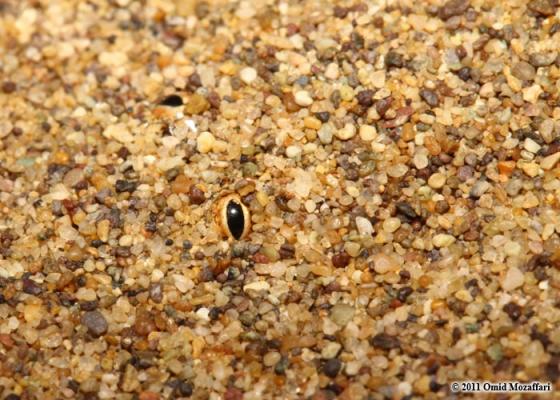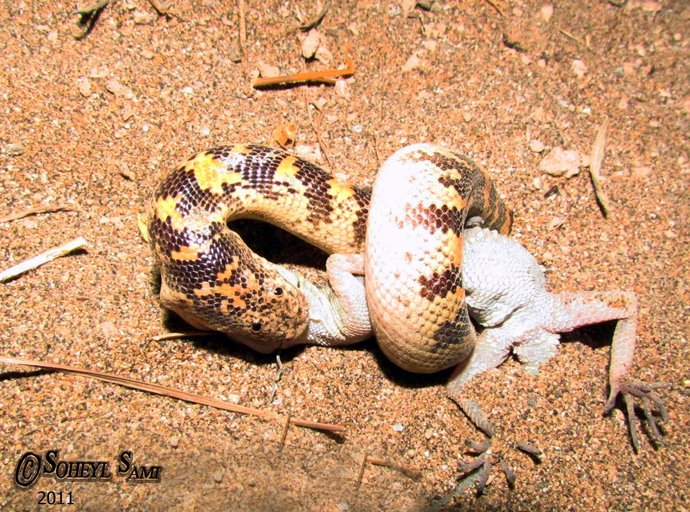Post by Ceratodromeus on Jun 17, 2015 23:26:45 GMT 5

Scientific classification:
Kingdom: Animalia
Phylum: Chordata
Subphylum: Vertebrata
Class: Reptilia
Order: Squamata
Suborder: Serpentes
Family: Boidae
Subfamily: Erycinae
Genus: Eryx
Species: E. jayakari
Description:
The arabian sand boa is a small desert dwelling Boiid. They are a colorful species, with a dark purple or black coloration and orange barring running down the back. the stomach and sides are a brown or white coloration. It is adapted for a burrowing lifestyle - the head is blunt and edge-shaped, with the eyes situated on top of the head; the tail is also stout. The arabian sand boa is a nocturnal species, spending most of its days underground, coming out of the burrows at night to forage. They are seen occasionally during the day, suggesting some activity occurs during daylight hours. They are a small, sexually dimorphic species, with the females attaining much larger sizes overall. Females average a total body length of 39cm(15in), while the males average a total body length of 33cm(13in).{1}

Geographic range:
This is a very widely distributed species, endemic to Saudia Arabia, Iran, and Oman.
Dietary habits:
The arabian sand boa emerges from its burrows at night to forage. It feeds primarily on lizards, which constitute as much as 50% of its diet in some parts of its range.{2} Species taken include Schmidt’s fringe-toed lizard( Acanthodactylus schmidti), Arabian toad-headed
agama (Phrynocephalus arabicus), Baluch ground gecko (Bunopus tuberculatus), and Sleven's sand gecko (stenodactylus slevini). Mammals also playa role in the diet of the arabian sand boa; species include Chessman's gerbil(Gerbillus cheesmani) and the Balochistan gerbil(Gerbillus nanus). Beetles are also noted prey animals.{1}

Reproduction:
The arabian sand boa is Oviparous, contrary to other members of Boiidae. The mating season is relatively long, like other members of the Eryx genus, lasting five months. A typical clutch size is seven eggs, which take two months to hatch.{3} The young measure 7.6-12.7cm(3-5in) in total body length, and resemble their parents in coloration.

References:
{1}Al-Sadoon, Mohammed K., and Fahed S. Al-Otaibi. "Ecology of the Sand Boa, Eryx jayakari in Riyadh Region of Saudi Arabia." Saudi journal of biological sciences 21.5 (2014): 391-393.
{2}Londei, Tiziano. "Arabian sand boa Eryx jayakari (Squamata: Boidae) preying on Arabian toad-headed agama Phrynocephalus arabicus (Squamata: Agamidae): a nocturnal-to-diurnal species interaction." Herpetology Notes 8 (2015): 155-156.
{3}Al-Sadoon, Mohammed K., S. A. Kandeal, and F. S. Al-Otaibi. "Reproductive activity of the sand boa, Eryx jayakari throughout the year in Riyadh region of Saudi Arabia." Life Science Journal 10.4 (2013).


